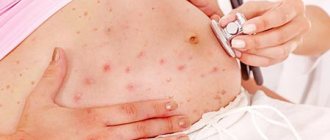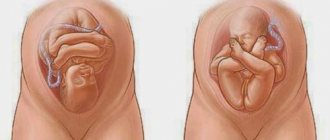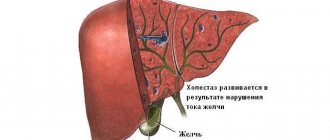Rash during pregnancy is a fairly common occurrence. The reasons for its appearance can be both physiological and pathological. In the first case, the rash will go away on its own after the baby is born; in the second, its appearance may signal an allergic reaction or a serious viral infection that can negatively affect the baby’s development and even provoke a miscarriage. How dangerous is a rash on the body during pregnancy, what can it signal, and most importantly, how to deal with it?
Itching and rash during pregnancy
If during pregnancy the expectant mother discovers a rash, she should immediately consult a dermatologist. Especially if the rash is accompanied by unbearable itching.
There may be several reasons for its occurrence:
- Allergic reaction.
- Viral infections such as rubella, herpes, measles or chickenpox.
- Polymorphic rash, gestational pemphigoid, prurigo of pregnancy, pruritic folliculitis, impetigo herpetiformis and other diseases accompanying pregnant women.
- Chronic skin diseases.
- Insect bites.
- Scabies mite.
Diagnosing a rash is not difficult - a routine visual examination is enough for the doctor. But in order to establish the cause of its appearance, it is necessary to collect anamnesis and identify other accompanying symptoms.
The location of the rash can tell the dermatologist the reason why it occurred. In some cases, the location of the rash does not matter. For example, with allergies, pregnancy dermatosis, or some viral diseases, the rash can spread throughout the body.
If a rash on a pregnant woman’s body is caused by infectious diseases, then the consequences will be extremely dangerous, including miscarriage, premature birth, or the birth of a weak baby with defects and pathologies, hopelessly lagging behind normal development.
Rubella during pregnancy is a viral infection that is accompanied by the following symptoms:
- rash all over the body in the form of small spots that do not merge with each other, pink-red shades;
- high body temperature of about 38 degrees, which can last up to 5 days and cause chills, headache and muscle pain;
- inflammation of the lymph nodes;
- catarrhal phenomena can complement the clinical picture in the form of rhinitis, conjunctivitis, cough or inflammation of the tonsils.
The best prevention against the rubella virus, which causes rubella, is vaccination. Since parents are now free to choose whether they will vaccinate their child, they can do it themselves at the pregnancy planning stage if a blood test reveals the absence of antibodies to a viral infection.
As a result of infection with the rubella virus, miscarriage or premature birth can occur, the development of defects and pathologies in the fetus, and the birth of a fetus delayed in development with possible external deformities.
Herpes during pregnancy - 95% of the world's population is infected with this virus, it is impossible to completely get rid of it, it remains dormant until the immune system weakens its defense. This is exactly what happens during pregnancy. It should be understood that the danger of the herpes virus can only exist if the pregnant woman has not encountered it before (and this is very rare) and became infected for the first time already during gestation. Symptoms:
- a small rash during pregnancy in the area of the lips, nasal mucosa or mouth, accompanied by itching and burning. In case of infection with genital herpes, itchy blisters fill the perineal area;
- elevated body temperature of at least 38 degrees;
- malaise, weakness.
Types and code according to ICD-10
Skin rashes can be divided into several types. Often the disease can be identified by the appearance of the rash.
Main types of rash:
- Red;
- Small;
- Acne;
- Bubble;
- Hemorrhagic;
- Pustular.
Red itchy rashes are most often caused by dermatosis (see photo). The itchy, small rash is usually caused by allergies, hormonal changes, or nervous urticaria or miliaria associated with excessive sweating. Acne appears during pregnancy due to a sharp increase in the hormone progesterone, which provokes excess sebum production.
You should not squeeze pimples during pregnancy; consult a dermatologist for recommendations! Blisters on the skin can be both a sign of an allergy and a symptom of chickenpox. If you experience itchy skin blisters, severe weakness, or a fever, you should immediately consult a doctor!
Important! Blistering rash is a sign of many diseases that threaten the health of the fetus. If multiple blisters are found on the skin, you should consult a doctor!
Rash on face during pregnancy
The most common cause of a rash on the face during pregnancy is acne, which, in turn, can manifest itself due to hormonal changes and non-compliance with hygiene measures. To minimize the risk of a rash, the expectant mother should regularly visit a cosmetologist and carefully care for her facial skin, using proven cosmetics that suit her personally.
A red rash on the face during pregnancy can also be a consequence of serious viral diseases, such as rubella, measles, chickenpox or herpes. In these cases, the rash may spread throughout the body and be accompanied by other symptoms that will allow the doctor to identify the infection.
Rashes requiring specialist consultation
An allergic reaction, which can occur during pregnancy, is often accompanied by rashes, including on the face. Allergies on the skin of the face can be caused by your favorite cosmetics. A hyperreaction to cold or household chemicals that accidentally come into contact with the skin of the face can affect the skin.
Can be used on any food product. Such rashes are accompanied by redness of the skin and severe irritating itching. Itching can cause not just discomfort, but lead to sleep disturbances and cause neurosis. Therefore, with such a rash, it is better to consult a specialist who will prescribe antihistamines and mild sedatives approved during pregnancy.
Herpetic rashes on the face are also a reason to visit a doctor. Most often, vesicles containing serous fluid and a huge amount of virions appear in the area of the edge of the lips or on the wings of the nose. Such rashes are usually called colds, but they can appear on any part of the skin of the face and even the mucous membranes of the eyes. If these rashes did not appear for the first time, it means that they arose as a result of the weakening of the immune system that accompanies pregnancy.
Reinfection does not pose a great threat to the fetus, since the mother already has antibodies to the herpes virus in her blood and her body begins to actively fight it. The risk to the fetus is minimal, but it exists, so it is better to contact a specialist who will recommend a competent model of behavior for the expectant mother and approved antiviral drugs.
We invite you to familiarize yourself with facial treatments in a beauty salon
Parasitic skin diseases, they are not specific to the gestation period. But pregnant women are not protected from the possibility of infection. Itching of the scalp, ears, eyelids, enlarged pores and severe itching, intensifying at night and after thermal procedures, pink and bright scarlet rashes are a sign of an attack by a miniature demodex mite. This infection does not affect pregnancy.
Scabies or scabies mite infestation is expressed in the appearance of blistering rashes on the skin and severe itching. This rash on the face is rare and is usually found on the extremities. Infection with scabies mites causes severe emotional discomfort; besides, it cannot affect the course of pregnancy in any way.
Dermatophytosis is a fungal disease that is transmitted through contact with a sick person or animal and through contaminated objects. The growth of fungal colonies is accompanied by itching; a round spot with flaky skin forms on the skin. This disease does not affect pregnancy, but it needs to be treated.
Rash on hands during pregnancy
A rash on the hands can be a signal of the onset of scabies in an expectant mother. This is a skin disease caused by scabies mites. The rashes look like blisters, localized between the fingers, on the wrists and elbow joints. They can also be observed in the genital area and on the mammary glands. In addition, you can see the passages of the scabies mite if the skin is not combed in these places. The rash in this disease is accompanied by itching of the skin, which is especially intensified in the evening.
Ideally, scabies should be treated before pregnancy, otherwise the list of ointments, aerosols and creams for scabies will be significantly reduced.
In addition, psoriasis or eczema can cause a rash on the hands.
Complications and prognosis
Despite the fact that the rashes described above are practically not dangerous, illiterate attempts to get rid of them can cause serious complications. There are many vessels on the face, and they are located close to the surface.
Attempts to squeeze out pustules in the nasolabial area can lead to pathogenic microorganisms being transferred through the bloodstream to large areas, and there will be more irritating rashes.
This alone is unpleasant, but the flow of blood in the veins of the skull can be paradoxical (that is, reverse, or retrograde outflow). In this case, pathogens can enter the nasal sinuses, cavernous sinus and meninges through the bloodstream.
By multiplying there, microorganisms can cause not only inflammation and thrombosis of the veins, but also inflammatory diseases of the human meninges. This is very dangerous and can cause the death of the patient.
Such complications are extremely rare, but possible. Therefore, you should not take risks, especially during pregnancy, trying to restore the skin to its former smoothness using such “wrong” methods.
Sometimes allergic rashes on the chest may leave small scar tissue or scars on the skin.
An allergic attack can provoke an exacerbation of bronchial asthma, eczema, hemolytic anemia, and serum sickness. In addition, the consequences of allergies often manifest themselves in the development of chronic bronchitis, rhinitis and many other dangerous diseases.
The appearance of hyperemia in the chest area, which spreads directly to the mammary glands, is quite dangerous.
It must be remembered that many patients associate allergic rashes during pregnancy with the development of mastitis, cancer, and lactostasis. In fact, the rash is often a mild form of dermatitis that can be treated with the right therapy.
It should be remembered that complications are easier to prevent than to treat, so it is necessary to promptly seek help from highly qualified specialists.
In most cases, the rash goes away without a trace after delivery.
For a viral or allergic rash, adequate therapy should be selected. The sooner a pregnant woman seeks help, the faster the situation will be resolved.
If not treated in a timely manner, scratching scars may remain on the body.
You cannot treat rashes on your own, as there is a possibility of missing the symptoms of diseases that are harmful to the intrauterine development of the child.
Rash on belly during pregnancy
A rash on the abdomen can be caused by dermatosis of a pregnant woman, which, in principle, appears only in expectant mothers. They begin, as a rule, from the area around the navel, gradually growing throughout the abdomen.
Viral infections can also manifest themselves as a rash on the abdomen during pregnancy.
Types of rashes during pregnancy
A dermatologist will help determine the cause of the rash not only where it is located, but also the type of primary element:
- Blister. It usually occurs immediately after an insect bite or an allergic reaction. It looks like a reddish round element rising above the surface of the skin.
- Vesicle (bubble). Talks about herpes, eczema or again, allergies. A small cavity that is filled with a translucent liquid.
- Bulla (bubble). It looks the same as a vesicle, but is larger - over 5 mm in diameter. May occur as an allergy or reaction to a drug.
- Pustule (pustule). A cavity filled with pus that rises above the surface of the skin. It happens with acne, as well as with various skin diseases.
- Spot. Or pigmentation, change in skin color. It may be a manifestation of pregnancy in the form of a vertical stripe in the lower abdomen or small spots on the face or chest. Or it speaks of some pathology, for example, urticaria or impetigo.
- Knot. A small lump, less than 3 cm, which may indicate eczema, ringworm or warts.
- Knot. A large compaction, which can indicate serious pathologies or formations, but it is very rare.
What to do if you have irritation under the breasts
The main cause of rashes on the chest is improper skin care.
Improper skin care is one of the main factors for rashes. A scattering of acne on the chest appears due to the fact that the pores become clogged with sweat and subcutaneous sebum if you neglect to shower. This is a comfortable environment for the proliferation of pathogenic bacteria, which causes inflammatory processes.
Pimples on the sternum often appear due to a lack of valuable elements. Vitamin deficiency is more likely to affect teenagers, expectant and nursing mothers, and people with heavy physical and mental labor.
If the rash appears together with severe itching and irritation, this may indicate the presence of skin diseases, such as eczema, shingles or one of the types of dermatitis, as well as an infectious process or allergy.
Allergens include pet hair, pollen, household dust, household chemicals, food, alcohol, and medications. For example, it can sprinkle on a person after taking antibiotics or iron supplements. A similar reaction to ultraviolet rays is possible after visiting the beach or solarium.
For the above reasons, a rash in the sternum area occurs in representatives of any gender and age. But there are certain factors that affect men, women or children specifically.
Among women
When pregnancy occurs, a rash may appear on the chest
Changes in estrogen synthesis in the body lead to excess subcutaneous fat, which usually manifests itself as rashes. For hormonal reasons, rashes occur in a woman if she:
- pregnant;
- breastfeed;
- waits from day to day for menstruation;
- had an abortion or lost a fetus;
- entered menopause.
Pimples on the sternum appear due to excess hormone synthesis in adolescents of both sexes.
A rash on the chest in women in the form of scarlet pimples that tend to itch and itch may be a reaction to a poor-quality or tight bra, popularly called urticaria.
In men
A rash on the chest in men indicates internal diseases
A rash on the chest in men can indicate internal diseases, in particular, pathologies of the stomach and intestines, kidneys, liver, and prostate. But most often the problem is neglect of personal hygiene rules.
If the rash on the male chest does not disappear within a couple of days even with regular bathing, and the itching and burning only intensify, you should immediately see a therapist or dermatologist.
In children
External manifestation of measles
In newborn babies, rashes can occur in the first days of life as a reaction of the skin to adapt to the new environment. Usually such manifestations pass quickly. In infants, rashes are often associated with the quality of the mother's diet and, accordingly, milk. A formula-fed baby may react with a rash to inappropriate formula.
Common childhood illnesses that cause rashes include:
- Miliaria is a rash of small itchy blisters that occurs due to blockage of the sweat glands due to excessive sweating. Usually concentrates on the abdomen, chest, buttocks.
- Exanthema is a skin rash that looks like spots, papules, vesicles, formed under the influence of pathogenic microorganisms.
- Chickenpox is a viral disease in which blisters grow and burst on the chest, face, arms, and legs.
There are several factors that lead to skin rashes:
- Allergy symptoms arise due to pathological processes that disrupt the functioning of various body systems.
- Redness on the chest may be due to a hereditary predisposition.
- The risk group includes women who are carrying a child. A rash on the chest during pregnancy indicates a decrease in immunity.
- Contact with irritating substances leads to the appearance of red spots on the chest. Quite often, a rash forms after using new cosmetics.
- Insect bites and household chemicals pose a danger to people.
A red spot on a woman’s sternum may appear due to an allergy to pollen or poplar fluff. Stress is another reason that causes a rash.
Allergic manifestations in the sternum in the form of red spots
Redness under the mammary gland may appear while feeding the baby. The situation is aggravated by the lack of personal hygiene. The spots may be the result of mastitis, which is accompanied by unpleasant symptoms. Women suffer from obstruction of milk flow, their breasts and mammary glands swell.
Redness in the neck and décolleté area sometimes appears as a result of exposure to skin breams. In this case, the patient develops additional symptoms: itching, severe burning, rashes of various shapes, accumulation of pus. The mite penetrates the ducts of the sebaceous glands and hair follicles.
It begins to actively influence the human body at the moment the immune defense decreases, and the patient experiences problems with the endocrine system, kidney function and gastrointestinal tract. Treatment in this case is also prescribed by the doctor after diagnosis.
When a person is healthy and all internal systems are working normally, the color of his skin is uniformly light. Any problems with the appearance of the skin indicate the presence of some problems in the body. Often people do not pay much attention to such minor symptoms until they spread to large areas of the body and worsen their appearance.
Today, experts identify a large number of reasons for the appearance of redness around the chest. For proper treatment and prevention of complications, it is important to promptly seek help from a doctor to diagnose and determine the cause of the lesion. Only a specialist can establish an accurate diagnosis and prescribe effective treatment.
Irritation under the breasts can begin for several reasons:
- Unpleasant symptoms appear when undergoing a course of treatment with antibacterial drugs.
- An allergic reaction occurs in patients who wear tight synthetic underwear.
- The risk group includes people who suffer from excessive sweating.
- Negative skin changes can occur in women with large breasts.
Decreased immunity leads to infection of the skin with various bacteria and fungi. Patients begin to complain of constant itching and flaking of the skin, and they develop a rash on the chest.
The presence of inflamed areas is complicated by the active proliferation of pathogenic microorganisms. An infectious infiltrate is released from the ulcerated layers of the epidermis, which has an unpleasant odor.
Rashes under the breasts occur in patients who suffer from hypersensitivity to household chemicals. In this case, it is necessary to completely avoid contact with irritating components.
Women are recommended to choose a bra made from natural fabrics. The presence of hard elements only increases the redness of the skin under the breasts.
You can reduce sweating by using baby powders for diaper rash. Particular attention should be paid to hygiene rules. Inflamed areas of the skin should be washed with soap 2 times a day.
To reduce unpleasant symptoms, it is necessary to regularly lubricate the skin with products that have anti-inflammatory properties.
Experts advise patients suffering from chest rash to adhere to several rules:
- If hives appear, you should consult a specialist who will help determine the cause of the disease.
- Patients must follow a hypoallergenic diet, which consists of completely avoiding irritating foods.
- Allergies may be caused by clothing made from synthetic materials.
- Patients are prohibited from opening the blisters, as damage to them can lead to the penetration of pathogenic bacteria.
To eliminate allergic dermatitis under the breasts, hormonal drugs (Advantan, Coderm) are used.
To cope with a fungal infection, patients are prescribed combination ointments with an antibacterial effect (Levomekol, Kremgen).
To cope with redness, non-hormonal ointments are used:
- Bepanten;
- We see;
- D-panthenol.
To eliminate allergic reactions, you can use ointments based on glucocorticosteroids:
- Hydrocortisone;
- Advantan;
- Lokoid.
A fungal infection can be recognized by rashes in the form of blisters and swelling. The hypoallergenic ointment Fenistil is considered an effective remedy for irritation. Before applying the product, you must thoroughly wash the chest area with soap and water. To treat allergies, zinc-containing ointments (Desitin, Zinocap) are used.
Rash during early pregnancy
The rash itself becomes dangerous for the expectant mother and fetus only if too large an area is affected, since in this case there is a risk of developing a generalized infection, sepsis. In other cases, the rashes are absolutely safe. The real threat may be what caused it.
The greatest danger to the health of the expectant mother and the life of the baby are infections such as rubella, chickenpox, measles or herpes. Appearing in the first trimester, they cause pathologies in fetal development, sometimes incompatible with life and ending in miscarriage. Or the baby will be born with defects and pathologies, weakened and lagging behind its development, and the pregnancy itself will be extremely difficult.
Allergy
Pregnant women often experience allergic skin reactions, even if the woman has not previously suffered from allergies. The reason for this is changes in the functioning of the endocrine and immune systems. A variety of factors can cause an allergic rash during pregnancy - food, medications, pet dander and much more.
Most often, such rashes look like small blisters or spots, papules. The rash is accompanied by severe itching and redness of the skin and can affect both individual areas of the body and its entire surface. An allergic rash is persistent and difficult to treat with conventional cosmetics or medications; The main condition for getting rid of it is to eliminate contact with the allergen.
We suggest you familiarize yourself with Thrush in pregnant women, treatment at home
Rash during late pregnancy
If the cause of the rash in the later stages was rubella, then it no longer carries the same danger to the fetus as in the first trimester. However, the expectant mother will have to undergo all kinds of screening tests in order to identify the development of pathologies and deformities in the baby, and in some cases, doctors may advise terminating the pregnancy. Only in the case of a lesion after the 30th week of pregnancy does the question of its termination not arise. The process of labor itself is taken under strict control, since the rubella virus will negatively affect it, causing severe bleeding.
Chickenpox, which appears in an expectant mother just a week before giving birth, can contribute to the development of neonatal chickenpox in the baby. This condition is dangerous due to its complications - encephalitis, inflammatory diseases of the liver and respiratory tract.
Measles
Measles is another viral disease that can cause skin manifestations. As with rubella, the first episode of infection usually occurs in childhood, after which immunity develops.
The measles virus enters the body through the upper respiratory tract, so the disease is accompanied by a severe cough. The rash usually appears a few days after infection and gradually affects different parts of the body: starting on the face, it spreads along the neck, arms, torso and down to the thighs, legs and feet. Measles rashes look like small bumps that merge with each other over a long course of the disease. A week after its appearance, the rash becomes pigmented, and the symptoms gradually disappear.
If infected in the first trimester, disturbances in the development of the fetus may occur, which lead to malformations. However, termination of pregnancy is not indicated in all cases. Treatment includes taking medications to relieve the symptoms of the disease.
Rash during pregnancy: how to treat it
Treatment of rash during pregnancy directly depends on the cause that caused it.
- For example, if we are talking about an allergic rash during pregnancy, then the doctor must determine what exactly triggered it. In case of food allergies, allergenic foods are excluded. If cosmetics are not suitable, it becomes necessary to replace them with another, hypoallergenic one. If you are allergic to a pet, the expectant mother will have to limit contact with it, etc. In severe cases, the use of special anti-inflammatory ointments may be prescribed.
- Infections require special careful monitoring of the patient by a doctor, often in a hospital, since they can lead to miscarriage, premature birth, and the development of defects and pathologies. Treatment is usually symptomatic; often the doctor may recommend an abortion.
- Dermatosis in pregnant women goes away on its own after delivery, and if the rash does not bother or itch, then no treatment is required. Or again, symptomatic treatment is carried out to alleviate the patient’s condition.
- For scabies, special preparations are prescribed, which are used to treat all the pregnant woman’s clothes, furniture, as well as the clothes of all her relatives living with her under the same roof.
Powders and talc effectively relieve friction in the area of irritation and are absolutely safe during pregnancy. Medications that doctors can prescribe to relieve itching in the area of the rash include:
- Fenistil gel. Prescribed for insect bites, eczema, urticaria, itchy dermatoses. Use during pregnancy is allowed in the first trimester after consulting a doctor; in the second and third trimester it is not recommended to use the gel on large areas of the body.
- Pimafukort. It can be prescribed for dermatoses, but its use during pregnancy should be accompanied by medical supervision and only after consultation.
- Akriderm. Prescribed for simple and allergic dermatitis, eczema, neurodermatitis. Long-term use during pregnancy, and especially in the first trimester, is not recommended.
It should be understood that in order to treat a rash it is necessary to clearly establish the cause that caused it. This can only be done by a doctor when examining the patient, collecting anamnesis and establishing symptoms other than the rash. Self-medication can cause consequences even more painful than the absence of treatment as such.
What kind of rash does a woman who is carrying a child get?
A rash during pregnancy very often appears on a woman’s skin. There is no need to panic when you see her. It is imperative to look for the reason that caused this. In most cases, skin rashes during pregnancy are a consequence of hormonal changes. But it is important to remember that, in addition to physiological reasons, there may be others that warn of the development of very serious pathologies.
- The first reason may be dermatosis, which, as a rule, is visible in the last months of pregnancy, due to hormonal changes in the body of the young mother. The main symptom of dermatosis is a rash similar to nodules and plaques, which are visible on the stomach, thighs - where there are stretch marks. After some time, the rash can merge and form large plaques that cover the buttocks, legs and even the back. A rash on the chest is also possible during pregnancy, but it disappears when the baby is born. Hormonal rash during pregnancy is not capable of harming mother and baby, and therefore is not dangerous.
- The second cause may be rubella. This is not just a rash, but a disease. Such a rash during pregnancy poses a danger to the child and mother. Rubella, which occurs in the first months, can cause cataracts, deafness, heart disease, and damage to the nervous system in the baby. Doctors recommend terminating a pregnancy if a woman has rubella in the first months of pregnancy. Symptoms of this disease: very small pale pink pimples appear all over the body, headache, nausea, and fever.
- A third cause of the rash may be measles. This rash appears during pregnancy in expectant mothers who do not have immunity to this disease. When a mother gets sick with measles in the first months of pregnancy, the baby is born weak-minded and has other pathologies. What are the symptoms of this disease? A rash similar to tubercles appears on a woman’s body. First of all, they are visible on the neck and face, and then on the torso and arms. The legs are the last to be affected. As with rubella, women who have had measles are advised to terminate their pregnancy.
- The fourth reason for the appearance of a rash can be herpes, which is an infectious disease. Most congenital diseases of the fetus occur after suffering this infection. If the expectant mother is infected with herpes for the first time, there is a 50% chance that the child may also be infected. When the disease already exists and it only worsens, infection of the baby is possible only in rare cases. It is possible to become infected with herpes through sexual intercourse, kissing, and through objects of daily use. Symptoms include: small red rashes with blisters containing clear liquid. They become red, itch very much and a strong burning sensation is felt. Time passes and ulcers form in place of the blisters. In the first trimester it is very dangerous to suffer from infection. As a result, there is a high probability that the baby will develop mental retardation, as well as problems with the cardiovascular system. If the mother got sick while pregnant in the last months and infected the baby, then in the future he may face problems such as encephalitis, hepatitis, pneumonia.
- The fifth cause is chicken pox. This disease is most dangerous in the first and last months of pregnancy. It often entails miscarriage and severe defects in the development of the baby. If the mother gets sick with smallpox in the last months, she can infect the baby, which will lead to pneumonia and hypoxia. The pathology has the following symptoms: pink spots appear on the body, with bubbles containing a clear liquid inside. After a while they become crusty and very itchy.
- Scabies takes sixth place in the ranking. With this disease, blisters and bumps form on the skin. Most often they are between the fingers and toes. The rash is very itchy, but does not pose a danger to either the mother or the unborn child.
- The seventh and final cause of rash is allergies. It is most common among pregnant women. In this position, the mother’s body can react in a special way to various substances, including allergens. With allergies, the rash takes the form of blisters and large red spots.
The rash on the body can vary. Each will indicate a specific disease, infection or pathology.
- Red rash. Appears, in most cases, due to dermatosis. It is not dangerous to the life of a woman or a child. It is very itchy if it appears in the last months of pregnancy. Those who suffer most from dermatosis are those pregnant women who are expecting twins or who gain weight very quickly while carrying a child. In appearance, the rash looks like small bumps.
- Minor rash. Occurs with urticaria. It is very itchy and uncomfortable. Most often, these are food allergies, hormonal disorders, and poor personal hygiene on hot days.
- Acne. The cause of such a rash during pregnancy is an increased level of progesterone and, accordingly, increased secretion of sebum or toxicosis, which leads to dehydration.
- Allergic rash. It is characterized by the appearance of very severe itching and occurs due to poor nutrition and medication.
- Hemorrhagic. It appears in the groin, on the buttocks, on the inside of the elbows, under the knees and armpits. This happens due to damage to the vascular walls by infectious agents - blood cells leave the vessels.
- Purulent rashes. Various microtraumas on the skin and infections may subsequently occur. This rash is very itchy. Reasons: weakened immunity, chronic diseases, increased sweating, contaminated skin.
The skin feels all the changes that occur in the hormonal and immune systems of the female body during pregnancy. Skin is an organ that comes into contact with the environment and performs protective, immune and excretory functions. The protective function is realized not only due to the mechanical barrier between the external environment and internal organs, but also due to the presence of immune cells in the skin.
The restructuring of the immune system during pregnancy is facilitated by the hormone progesterone. Progesterone inhibits the specific immunity of a pregnant woman, that is, the activity of immune cells in relation to pathogens of previous infections (acquired immunity). This is done so that immune cells do not accidentally “confuse” fetal proteins with pathogen proteins (both are foreign to the mother’s body).
This suppression of specific immunity is necessary to maintain pregnancy and prevent rejection of the fertilized egg as a foreign body. At the same time, nonspecific protection increases, that is, immune cells called monocytes are activated. They protect the body by ingesting foreign substances and digesting them - this is called phagocytosis.
During pregnancy, the skin of the abdomen stretches, elastic and collagen fibers are damaged. Damaged fibers can be perceived by the mother's immune system as foreign - which is why allergic rashes most often occur on the stomach.
Causes of itchy rash in pregnant women can include pregnancy-related and non-pregnancy-related conditions. All those skin diseases that occur only during pregnancy and after childbirth, but are not observed in non-pregnant women, are called dermatoses of pregnancy. Dermatosis is a painful skin condition that has specific causes and characteristic symptoms.
We suggest you familiarize yourself with what a birthmark on the back means
Since pregnancy is a temporary condition, pregnancy-specific skin diseases are designated precisely by the term “dermatosis.” The remaining skin pathologies during pregnancy are divided into dermatoses provoked by pregnancy and skin diseases not associated with pregnancy. Unlike dermatoses, dermatitis is usually characterized by a chronic course and a pronounced inflammatory reaction.
Dermatoses that occur only in pregnant women include:
- polymorphic rash of pregnant women (pregnant prurigo, pruritic urticarial papules and plaques in pregnant women);
- herpes of pregnant women (pemphigoid of pregnant women);
- intrahepatic cholestasis of pregnancy;
- atopic rash of pregnant women.
Dermatoses in pregnant women are more often observed in the following cases:
- multiple pregnancy;
- first pregnancy;
- the age of the pregnant woman is over 30 years;
- pregnancy with a male fetus;
- excess weight of the expectant mother.
It is believed that all of the above factors increase the load on the pregnant woman’s immune system, so the risk of allergic reactions is much higher. In addition, these factors increase the stretching of the abdominal skin. The later in pregnancy dermatosis occurs, the more it is associated with hormonal changes, since the placenta secretes more hormones with each week of pregnancy.
Pregnancy herpes is an autoimmune skin disease that develops during pregnancy and after childbirth, but is quite rare, with an incidence of 1 case in 10 thousand pregnancies. Despite the name of the skin pathology, this rash is not caused by the herpes virus. The disease was called pregnancy herpes due to the external similarity of the rash to the rashes that occur with the herpes virus, as well as due to the presence of severe itching.
Now this dermatosis is called pemphigoid of pregnancy. Other names for this skin pathology are gestational herpes, gestational pemphigoid. Gestation is the term for pregnancy. Dermatologists call pemphigoid a type of rash that is characterized by the formation of blisters (pemphigus - a bubble) on the skin, but is not characterized by degenerative changes in the skin, that is, the rash with pemphigoid goes away without a trace.
Rash during pregnancy: photo
Let's summarize: rash during pregnancy
Treatment of the rash, as a rule, is not required - the causes that caused it are treated, and if it is accompanied by severe itching, it is removed with the help of special cooling ointments and gels, which are allowed during pregnancy.
A rash during pregnancy is a signal that the expectant mother has some kind of malfunction in her body, and this should not be ignored under any circumstances. It is better to immediately make an appointment with a dermatologist and tell in detail how, under what circumstances the rash appeared and what other signs accompany it. The sooner he makes a diagnosis, the easier the treatment will be and the fewer consequences for the health of the expectant mother and her baby.
Prevention
To avoid developing urticaria, the expectant mother should follow some tips:
- Follow a hypoallergenic diet. It involves giving up chocolate, citrus fruits, nuts, seafood and other similar products.
- Throughout the entire period of expecting a child, you need to eat healthy food. You should avoid store-bought semi-finished products that contain large amounts of preservatives and chemical additives.
- Throughout the day you need to adhere to the optimal drinking regime. In the absence of edema, it is recommended to drink at least 1.5 liters of liquid per day.
- It is necessary to minimize skin contact with cosmetics and household chemicals, which become a common cause of allergic reactions.
If you experience any alarming symptoms indicating the development of urticaria, you should immediately consult a doctor . Otherwise, the disease can negatively affect the fetus or the health of the expectant mother.
kozhainfo.com









